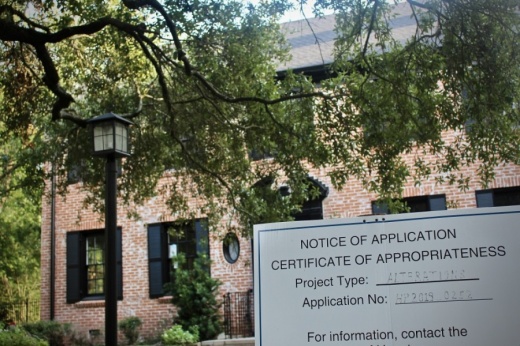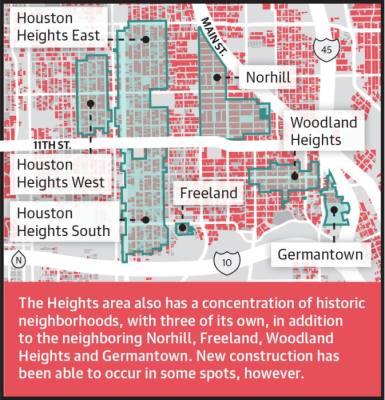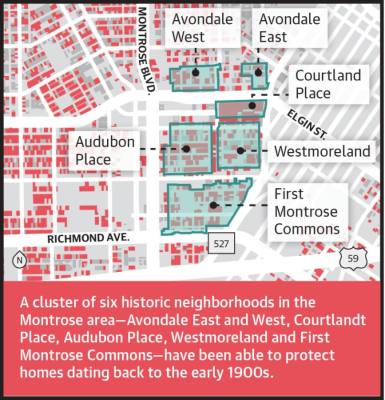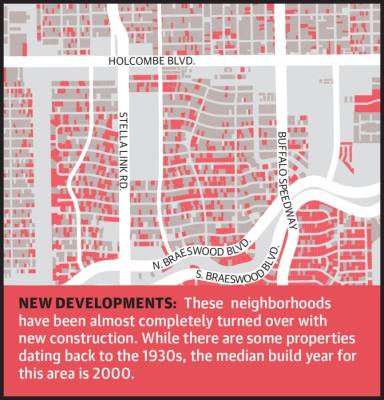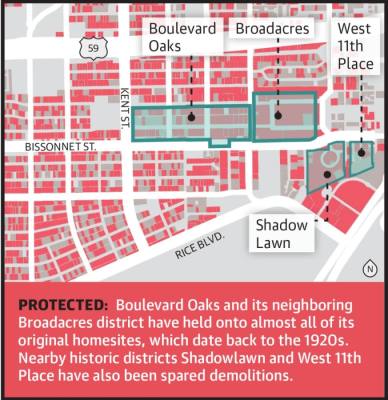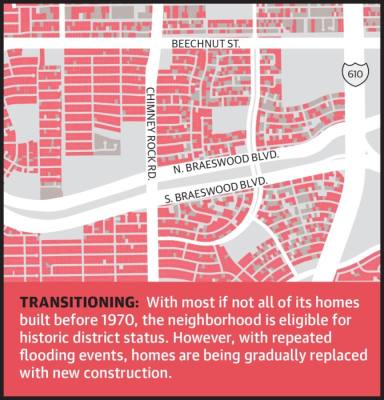According to Pei-Lin Chong, a real estate agent and builder specializing in restoring historic structures, Houston’s historic preservation law, which turns 25 this year, reflects the city’s struggle with its own identity—a purportedly world-class urban destination that bulldozes its past.
“In Houston there’s no great love, no real pursuit of historical preservation. It’s very neglected,” Chong said.
Rapid development throughout its history, including its sprawling network of highways, has erased swaths of Houston structures and neighborhoods, preservationists say.
For the past 25 years, Houston’s historic preservation law, first passed by City Council ordinance in 1995, has been a work in progress. The ordinance has been used to designate 22 neighborhoods and 400 landmarks across the city for protection against demolition and significant alteration.
“You can always build new, but you can’t build historic,” said David Bush, executive director of Preservation Houston, a nonprofit that works to recognize historic restorations and provide guidance in the process. “So the effect has been, it has created choices for people. Not everyone wants to live in a three-story townhouse. And once a neighborhood is gone, it’s gone.”
The ordinance, which preservationists say has already fought an uphill battle to offer more than an honorary title to properties and neighborhoods, is now facing its biggest challenge: a suit in the Texas Supreme Court that, if successful, could mean Houston’s efforts to guide development without zoning will have to go back to the drawing board.
Preservation progress
In 1995, two years after a failed referendum—Houston’s third attempt to establish zoning—City Council passed the historic preservation ordinance.
In its initial form, it established the Sixth Ward as a historic district and created a path to designate historic landmarks, but it lacked development restrictions.
“You could have a landmark, but it could still be demolished,” Bush said. “All you had was a 90-day waiting period. ... The idea being that you had 90 days for someone to buy the property and try to save it. Well, that didn’t work.”
Neighborhoods were also given a pathway to establish themselves as historic districts, initially by getting 51% of its residents to agree to a petition before going to a City Council vote. Later the standard was raised to require 67% of residents to agree to the measure.
Gradually, the ordinance was reinforced. A protected landmark status was created to prevent demolition of notable structures, and in historic districts, development regulations became mandatory, with building permits approved only after a project could be vetted.
The Houston Archaeological and Historical Commission was established to oversee the process of qualifying a project through “certificates of appropriateness,” which enforce the ordinance and any existing design criteria related to the architecture and materials of a property and its surrounding neighborhood, which vary widely by district.
“You might have someone say ... ‘my windows are not energy efficient, I want to replace them,’” said Geoffrey Walker, who has helped oversee preservation work in Boulevard Oaks, south of the Montrose area. “But you can’t. That’s the way it is.”
Typically, non-street facing updates are less regulated, and the color of a house is also free game, but larger updates and modifications are subject to review.
However, even ardent preservationists face difficulties because of delays in the process of receiving approvals, as well as ambiguities in the ordinance itself, said Chong, who was involved in establishing a historic district for First Ward. Another headache has been simply implementing the design rules in the first place, she said.
“We established the district in May 2014. We drafted design guidelines and submitted them. Six years later—still in draft,” she said. “It creates a lot of frustration.”
Neighborhood level
The ordinance has allowed small pieces of Houston’s history to remain intact, preservationists say.
The Old Sixth Ward district, for example, has been able to maintain its stock of homes, some of which are over 120 years old, and leaders are now working to update its guidelines to allow property owners some flexibility in implementing flood protections and more sustainable practices.
“The Old Sixth Ward is the oldest intact neighborhood in the city,” said Danni Sabota, the neighborhood association president there. “Having the protection of the ordinance has been a critical resource for saving our past and giving historic property owners guidance on how to restore and rehabilitate their properties.”
The nearby High First Ward District has also been able to hold onto more old properties than it would have if trends had continued, Chong said, but it was too late for some blocks of the neighborhood.
“If we didn’t have our version of a very small historic district, this entire neighborhood would be like Rice Military,” she said, referring to the widespread use of townhome developments to replace old bungalows and other residential lots in the neighborhoods east of Memorial Park. “And I’m sorry, but Rice Military is decimated. It’s almost gone.”
Because historic preservation is set up to be a neighbor-led effort by design, communities that are not already cohesive may not be equipped to organize. When the ordinance started requiring a supermajority of residents to back a district, it resulted in smaller areas being designated.
“They have been fairly small districts, because the homeowners all know each other and they have a common idea of what they want,” Bush said.
Any neighborhood built before 1970 is eligible for historic district status, but aside from Glenbrook Valley in south Houston, no efforts have been made to organize the city’s mid-century neighborhoods.
“It always takes leadership,” Walker said. “Somebody has to think it’s a good idea. And I think you could only use this ordinance to preserve a neighborhood that had already had sense of itself, liked the way it was and wanted to keep itself intact.”
Because it takes such great effort to organize, and because there are dissatisfied stakeholders on either side, Walker said this means the ordinance may be the most ideal for a city without zoning.
“It was, to me, the perfect Houston answer,” he said. “One cry you hear is, ‘Oh, it’ll prevent the highest and best use,” meaning what can make the most money. And another is, ‘I don’t want the world to change around me.’ ... It really doesn’t satisfy either of those people.”
Court challenge
However, that answer is now being questioned at the state’s highest court.
“We aren’t saying historic preservation isn’t worth keeping,” said Matt Festa, a law professor who is representing Heights residents Kathleen Powell and Paul Luccia in the case. “It’s just that the city didn’t go about it the right way.”
The fight began after the preservation ordinance was bolstered in 2010 with new enforcement mechanisms, making its requirements more difficult to evade. At the time, a “transitional ordinance” was also passed, allowing district residents to reconsider whether they wanted to remain under the district designation.
The Heights East Historic District did just that, but after the resident survey failed to find 51% in opposition, the district remained in place, compelling Powell and Luccia to file suit in 2014, according to court filings.
Their central argument was that the ordinance constituted zoning—a specific area of law that oversees land use, and one that was explicitly banned by a Houston charter amendment in 1994.
“Once the ordinance got the teeth of the force of law, it became de-facto zoning,” said Festa, who pointed out that Houston has a host of other zoning-like practices, such as special minimum lot size, that raise concerns as well. “If Houston really wants to do this, it needs to enact zoning. But voters have said that is something they do not want.”
While a county court sided with Houston in 2017, as did a state appeals court in 2019, Festa said the Supreme Court should consider the case because how cities should follow their own charters should be clarified.
In an amicus brief filed in support of the city’s case to protect the ordinance, Houston native and historic preservation law expert Sara Bronin argued Houston’s measures are well within the bounds of city governance.
“Houston, in lieu of zoning, decided to regulate the exteriors and appearance. It’s distinct from zoning, which determines what you can do with a property, commercial or residential, for example,” she said.
Briefs have been filed by both sides in the case. The court can decide to hear the case and make a ruling, or it could refuse, thus maintaining the appeals court decision.
Festa said that the bigger question he hopes the court can resolve is, to what extent can residents overrule other property owners.
“As it is now, it lets neighborhoods basically say, ‘Hey let’s stop this kind of development,’” he said. “That’s sort of a neighborhood veto. That’s not how democracy works, at least not how it’s defined in Houston.”




